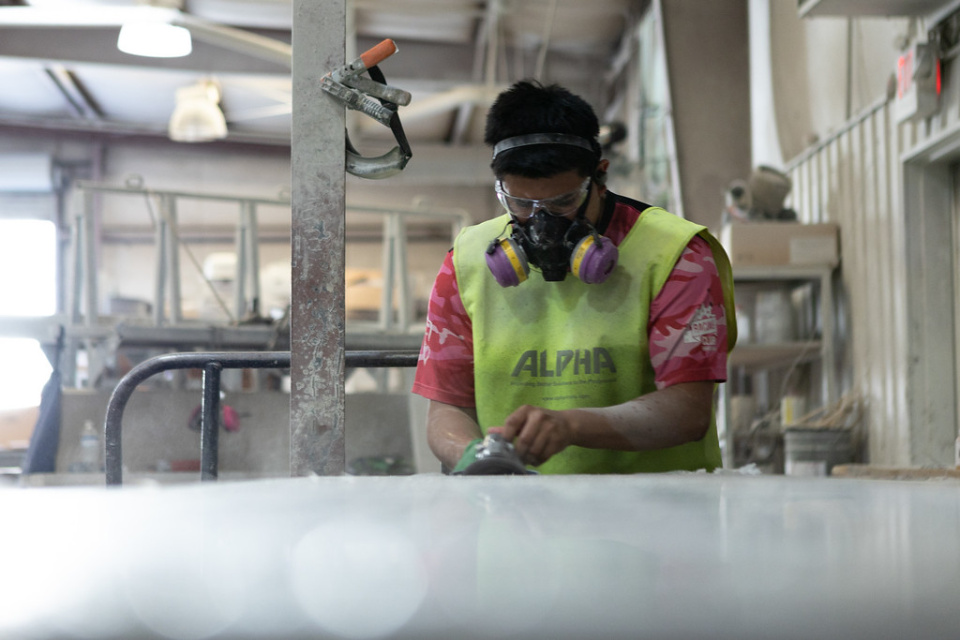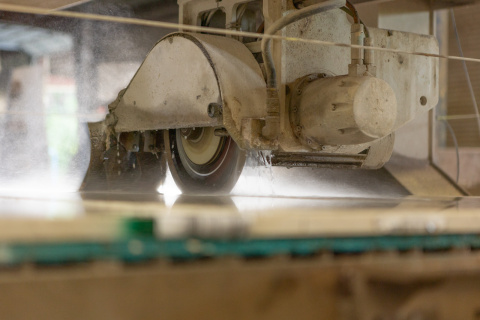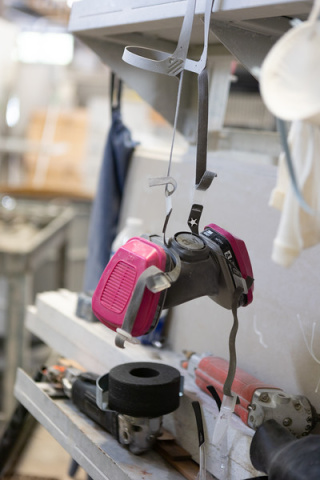Scientists Pinpoint Hazards for Engineered Stone Fabrication Shop Workers

You've probably seen fabricated stone countertops on an HGTV remodeling show — and you might even have them in your own home.
The durable, affordable, and highly customizable product debuted in Italy in the 1970s and continues to grow in popularity. Between 2010 and 2018, U.S. imports of engineered stone slabs increased by 800%. One report predicted that global demand will increase 5.4% each year, to reach 97 million square meters by 2028.
Sometimes referred to as manufactured stone or quartz (which is, confusingly, also the name of one of its main components), to the untrained eye, the material looks no different from natural stone. One of its biggest advantages is that it can be made to resemble marble, granite, or nearly any other stone.
Beneath the material’s familiar smooth surface, however, lie safety risks for engineered stone workers.
Research conducted by a team of Georgia Tech scientists demonstrates that everyone in a fabrication shop is at risk, not just the workers cutting and fashioning the material.
The group included members of the Enterprise Innovation Institute’s Safety, Health, and Environmental Services (SHES) program: Jenny Houlroyd, Hilarie Warren, Brandon J. Philpot, and Sean Castillo. Together with Jhy-Charm Soo of Georgia Southern University, they recently published their findings in Oxford Academic.
The study divided engineered stone workers into four risk groups and charted their relative exposure to the material’s chief hazard: respirable crystalline silica.
A “Toxic Product”
Engineered stone differs notably from its natural counterpart, both in composition and in danger to worker health.
A stone slab cut from the ground, such as granite or marble, comprises several different minerals and typically has a concentration of 40% or less of mineral crystalline silica — usually quartz, which is the most abundant form of crystalline silica.
Engineered stone, however, can contain more than 90% silica. Slabs are produced when silica is crushed, combined with synthetic resins, and compressed using heat or pressure.
During fabrication, these slabs are cut and shaped by powered hand tools. The resulting dust contains tiny particles of respirable crystalline silica. Once inhaled, some of the particulate may stay in the lungs and cause an inflammatory response.
While crystalline silica is released from both natural and engineered slabs during fabrication, the engineered slabs’ significantly higher percentage of silica poses a much greater risk to human health.
A growing body of research indicates that breathing engineered stone dust leads to lung inflammation and can cause acute silicosis, an untreatable lung disease.
“I would classify engineered stone as a really toxic product,” said Houlroyd, manager of occupational health services at SHES. “When you have something that’s high-risk, you have to prepare for systems to fail and have backup measures.”
Committed to Safety
Over six years, the SHES research group collected air-sampling data, making 17 visits to 11 Georgia stone fabrication shops. The shops had all requested air-sampling services offered by SHES.
“The companies agree that by working with us, they commit to correcting the hazards and reducing exposures, as much as is feasible,” Houlroyd noted.
Because most kitchen and bathroom countertop fabrication shops are small employers, workers often complete a variety of tasks, resulting in a range of exposure factors.
The research team recommended that all manufactured stone fabrication workers wear respirators, such as an N95 mask. For employees who are the most exposed, they recommended a respirator with a powered air-purifying element or supplied air.
But personal protective equipment (PPE) alone does not ensure safe conditions.
“Most of the workers in this industry are relying on respirators as their primary source of protection, and they need a lot more to protect them,” explained Houlroyd. “PPE is the last line of defense, and safety needs to be addressed from all angles.”
Part of that multifaceted strategy includes repeated monitoring of air quality and equipment. It’s also crucial for employers to make sure that exposure risks are understood by all workers — not just employees, but also contract and day laborers, as well as those working for cash.
More Than Just a Job
As members of SHES, the Georgia Tech research team members are first and foremost health and safety consultants, with expertise spanning industrial hygiene, environmental compliance, and Occupational Safety and Health Administration (OSHA) regulations.
For Houlroyd, worker safety is not just a professional calling; it’s also a personal mission.
“My dad got sick with brain cancer from exposure to contaminants on the job, and he died four years ago,” she said.
“Though he didn’t work in the manufactured stone industry, his story is representative of many people who go to work each day to feed their family, are not aware of workplace hazards, and then find themselves sick.”
The public can play a part in worker safety, too.
“Consumers have a choice and can educate themselves about what type of countertop materials they choose to have installed — like how we look at food labels for nutritional information,” said Warren, who oversees the OSHA Training Institute Education Center at Georgia Tech.
“We should be aware of the risk to workers, as well as how the installation process in our homes should be properly managed to prevent dust contamination,” she added.
A Zero-Risk Solution
In 2024, Australia eliminated the risks associated with engineered stone fabrication. Despite having enacted stronger regulations in 2019, the country continued to see a rise in silicosis cases resulting from exposure to respirable crystalline silica.
Australia’s solution? Enacting a ban on the import and fabrication of the material until its safe manufacture can be demonstrated.
In their report, the Georgia Tech group recommends that the U.S. do the same. As Houlroyd put it, “I would love to see our country find a safer substitution and take this dangerous product off the market.”
____________________
Title: “Respirable dust and respirable crystalline silica exposures among workers at stone countertop fabrication shops in Georgia from 2017 through 2023”
Conflict of interest: Jenny Houlroyd has served as an expert witness in silicosis legal cases unrelated to this research. All other authors declare no conflict of interest.
Funding: The U.S. Department of Labor, Occupational Safety and Health Administration (OSHA) as part of the OSHA 21(d) Consultation Program grant.
Additional Media

On average, fabrication stone plants use about 10,000 to 15,000 gallons of water per day. This saw is cutting though a slab of manufactured stone as water runs to keep the machinery from overheating, mitigate dust particulates, and polish the stone. (Photo: Mixed Bag Media)

Masks such as this respirator are an important tool for workers in stone fabrication plants. To prevent silica dust and other particulates from damaging their components, experts say respirators should be stored in clear, plastic bags or containers when not in use. (Photo: Mixed Bag Media)